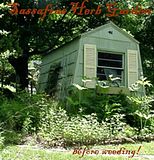(Sweet Annie, Annual Wormwood, Artemisia Annua)
I’ve grown Sweet Annie for a dozen years or so, and find it to be one of my personal favorites.
It’s grown not only for the feathery foliage but also for the fragrance. (Varieties with no fragrance have also emerged.) Although an annual, it reseeds itself abundantly, generally not where one expects to find it. In many parts of the country it grows in the wild, along roadsides, and such.
Sweet Annie can quickly become a nuisance and perhaps it’s best to purchase it harvested and ready to use rather than grow it yourself. I myself use a huge amount and celebrate each and every stray seedling I find, but gardeners who like neat tidy little gardens and some farm folk friends find it to be a curse.
Sometimes it comes up painfully slow in spring time, then suddenly bursts into growth when the weather gets better. Some years it grows better than others, as do most other things. It likes well drained soil and not too much rain!
When it does emerge in the spring, it will appear as teeny little ferny things.... From the beginning they have a fragrant smell when squeezed between your fingers, which will help you to distinguish them from weeds. I let mine grow a few inches before disturbing them and then move them where I’d prefer them to grow. If they come up in a walkway, I pot them up for the time being, then transplant to the garden once they’ve grown big enough.
I grow Sweet Annie in my herb garden, and as a filler / background plant in my perennial gardens, and in every other nook or cranny I can tuck a plant into. It needs ample space (2 ft), and full to partial sun to grow to its full potential (4 ft and more). It blooms late summer or early autumn and should be harvested once the yellow blooms appear, but before blooms open fully. Allow some plants to remain in your gardens and drop seed if you’d like it to reseed.
After harvesting, tie a few stalks together and hang upside down to dry in a cool dark airy place. I spread newspaper underneath to gather any stray seed and, once dried, store the dried stalks in a large kraft paper bag to collect further seed. I also scoop up all fallen seed and stray plant materials while crafting with it and throw them outside in my gardens, in late fall, in winter (throw it right on top of the snow), or early spring.
A word of caution… For some folks, handling the plant materials or breathing the pollen may cause an allergic reaction, sometimes severe.
Sweet Annie is perhaps not the most attractive plant during the growing season, because of it’s height, and because it’s generally pretty thin at ground level, however I fill in the space around it with “garden art” if needed… a rusty watering can, a few stacked clay pots, a vintage child’s tricycle, etc.
Sweet Annie is a must-have for primitive crafters, and for floral designers. It’s perfect for dried wreaths and swags, to tuck into Christmas stockings or primitive seedbags, to tie onto primitive soaps or candles, or simply to wrap your doll’s arms around.
Other favorite I like to dry and use with Sweet Annie include, but are not limited to, Queen Ann’s Lace, Sage, Tansy, and wild Rosehips.

 Hilltop garden with rusty old chair and chipmunk abode!
Hilltop garden with rusty old chair and chipmunk abode! 
 Hilltop garden with one of hubby's many birdhouses...
Hilltop garden with one of hubby's many birdhouses... 
 Wild section of the yard with bedframe trellis, funky signs, and treasure pole...
Wild section of the yard with bedframe trellis, funky signs, and treasure pole...
 The kiddo's treehouse, way up there...
The kiddo's treehouse, way up there...
 Arbor and fence at the entrance to backyard...
Arbor and fence at the entrance to backyard... One of my lovies!
One of my lovies!
 Veggie garden beds in springtime.
Veggie garden beds in springtime. 
 My garden shed with new paint
My garden shed with new paint
 Messy old perennial bed with lots of weeds. Another day...
Messy old perennial bed with lots of weeds. Another day... 
 Springtime "weeds" in the veggie garden, how pretty!
Springtime "weeds" in the veggie garden, how pretty!
 More early spring flowers
More early spring flowers






